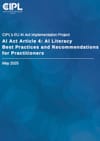📚 What’s Covered
This white paper from CIPL offers clear, actionable best practices for complying with Article 4 of the EU AI Act, which mandates AI literacy among providers, deployers, and affected individuals. The authors approach this through a lens of operational maturity, targeting organizations at various stages of AI adoption—from early-stage implementers to mature, AI-native firms.
The core of the guide is a set of eight well-developed best practices. These include:
- Top-Down Sponsorship: Leadership buy-in is foundational. The guide suggests practical steps, like organizing open workshops and aligning AI literacy with M&A readiness.
- Integration into Broader Compliance: AI literacy should not live in a silo. CIPL urges practitioners to align it with existing digital compliance programs—from GDPR to cybersecurity.
- Inclusive Literacy: The paper expands the concept of literacy beyond employees to third-party vendors, users, and even the public through open resources and academic partnerships.
- Cross-Functional Ownership: Organizations are encouraged to create “AI boards,” identify ambassadors, and organize “pitch days” to democratize literacy.
- Shared Vocabulary: The guide advocates for organization-wide taxonomies and decision trees to demystify AI definitions and streamline governance.
- Context-Aware Training: AI education should be role-specific, scalable, and flexible. Ideas include personalized learning hubs and internal mentoring.
- Hands-On Practice: Literacy isn’t just theory—employees should get opportunities to apply what they learn in real-world AI projects.
- Feedback and Continuous Improvement: Organizations should track metrics and adapt literacy efforts based on stakeholder feedback and regulatory shifts.
A visual framework (on page 4) maps these best practices into CIPL’s broader Organisational Accountability Framework, reinforcing that AI literacy isn’t just training—it’s part of a compliance and trust-building culture .
💡 Why it matters?
AI literacy is now legally mandated in the EU, but most organizations still treat it as optional or limited to isolated training modules. This paper reframes it as a cross-cutting competency—on par with data protection or financial compliance. It’s especially valuable for those tasked with implementation but unsure where to begin. By offering real-world practices, it shifts the narrative from abstract obligation to strategic opportunity. It also goes beyond employees, recognizing literacy as a systemic asset for customers, vendors, and the public.
🕳 What’s Missing
While the guide is rich with practices, it doesn’t tackle budget planning or resource allocation—which are make-or-break issues for AI literacy implementation. There’s also limited discussion of evaluation metrics beyond general KPIs or qualitative feedback. Templates, readiness checklists, or literacy maturity models would have made it even more actionable. And while CIPL references the need for AI transparency and explainability, there’s less about technical integration (e.g., model cards, logs, documentation).
👥 Best For
- AI governance leads seeking Article 4 compliance playbooks
- Risk, legal, and HR teams setting up training structures
- SMEs and large firms scaling AI programs
- Educators and institutions creating public AI literacy campaigns
- Vendors and third parties looking to align with deployer obligations under the AI Act
📎 Source Details
Authors: Centre for Information Policy Leadership (CIPL)
Title: AI Act Article 4: AI Literacy – Best Practices and Recommendations for Practitioners
Publication Date: May 2025
Link: www.informationpolicycentre.com


